Japan 2008
Journey to Japan 2008 - diary
21st August 2008
Departure Mumbai 23.30
22nd August
Transit via Bangkok, arrival Tokyo's Narita Airport 15.45 local time. Accommodation in Hotel Keio Plaza hotel Tokyo.
23rd August - Tokyo
We were tired by traveling and jet lag and intentionally did not set the alarm clock – so we slept up to ten. Then the first adventure started – how to understand the system of Tokyo subway. As the signs were not always in English our only rescue was a map – but we managed. We wanted to buy tickets for famous Tokyo theatre Kabuki-za. Half an hour queuing was rewarded and we could follow two-hours show called Tsubakuro Wa Kaeru (Yasunosuke's Search for Home.). It was sort of a mirror of Japanese soul. Synopsis: A kind carpenter befriends a boy whose mother was forced for financial reasons to become a Geisha in Kyoto and takes care of him.
In the evening we had a business meeting.
24th August - Tokyo
In the morning we had to get on the bus at 8.05 for sightseeing tour. All was organized by a young Japanese woman who wore leggings ending at her knees with a loose smock over it. The leggings emphasized her thin skewer like legs formed to the shape of O. Later on we found out that from unknown reason such a gear seems to be something like a uniform for Japanese female guides (especially the leggings) and that O shaped legs are also a fairly common phenomenon.
We visited the following sites:
Meiji Jingu Shrine – Shinto temple built in honor of Emperor Meiji in 1920 who was the first emperor of modern Japan and ascended to the throne in 1867 at the peak of the Meiji Restoration (he passed away 1912). A torri gate along the forested approach to Meiji Shrine is very impressive – the complex is huge and offers space for walks and meditation.Some young people rehearsed for a dance performance in the courtyard, they were colorfully dressed and although they did not speak English they seemed happy to see us, smiled, bowed to us and performed for us.
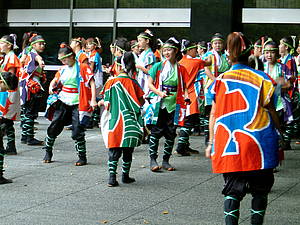
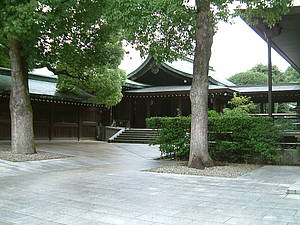
01 - Tokyo - Meiji Jingu Shrine
Imperial Palace East Garden. A beautiful garden, like many others, which are to be admired, manicured in a Japanese art, looking as if it were bonsai in large. Currently almost nothing was blooming, but everything was wonderfully green.
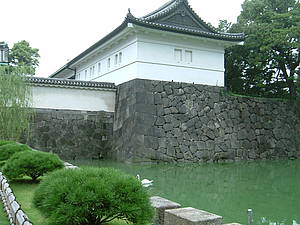
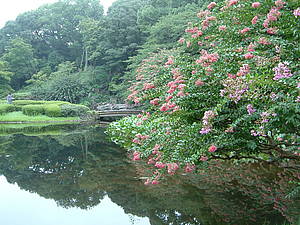
02 - Tokyo - Imperial Palace East Garden
Sensoji Temple (Asakusa Kannon) - Buddhist temple with all the typical epithets, coupled with a shopping arcade with goods of rather tourist quality.
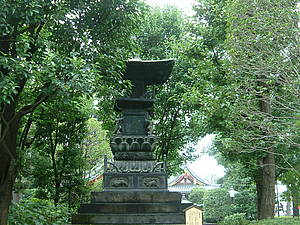
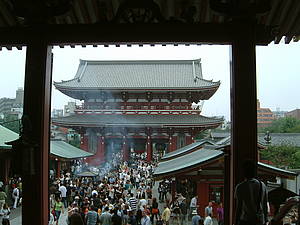
03 - Tokyo Sensoji Temple
Lunch in a restaurant on the 14th floor overlooking the harbor.
Boat Ride - An hour ship ride down the river with a view of Rainbow Bridge and the Statue of Liberty, the bridge looks like Golden Gate in San Francisco, and the Statue of Liberty – it somehow looked like not really belonging there. We were also not impressed too much by the Tokyo Tower, which is a symbol of Tokyo. It sort of looked like Eiffel Tower in the wrong place (the right one still belongs to Paris!).
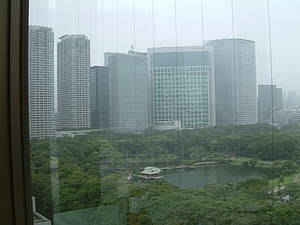
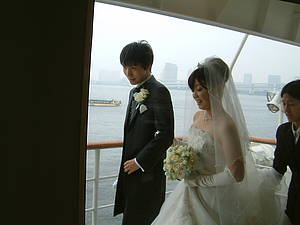
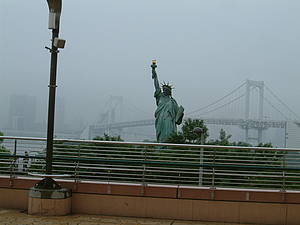
04 - sightseeing from the ship
Unfortunately, the guide did not seem to be knowledgeable, he did not tell us anything about the history or the presence of the country, he just tried to organize us all the time so that nobody would get lost and was only constantly repeating the names of the sites we had already seen and what we were still going to see, what we were allowed to do and what not. So that everybody would understand, he had written the names of monuments and his instructions on pieces of paper which he held over his head. His only interest seemed to be the imperial family, he permanently showed photos not only of the emperor and his wife, but also of their two sons with families and was describing them in all details. He also had an unfortunate habit (but as we found later that was the local habit of all guides), that the schedule was calculated up to the minute, including time destined for using the toilette. The availability of bathroom had been constantly reminded, he was sort of insisting that everybody should use it when the time was scheduled for that – it was funny, a real kinder garden.
25th August
A trip to Nikko (the name means Sunshine). We were quite impressed by this vast complex, located in the middle of beautiful nature and by the existence of Shinto and Buddhist shrines next to each other. The sanctuary was founded by in Japan highly estimated Tokugawa Ieyasu, the founder of the third shogun empire and Edo culture prosperity. The special mixture of the two major religions including both spiritual and tourist elements is difficult to be described. The next trip went by road with numerous hairpin bends to a beautiful lake situated 1200 m high (Nikko is about 600 meters above sea level) and to the Kego Waterfalls which were unfortunately all hidden in the fog.
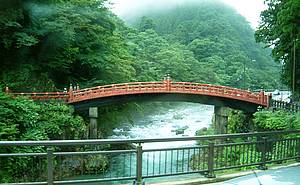
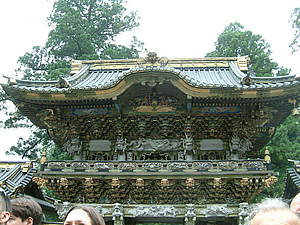
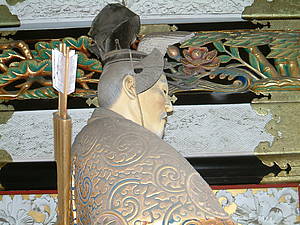
05 - Nikko
26th August
This time the guide was very good. He told us a lot about history and religion of the country.
History
After 1100 the imperial court lost control over the country and main discords were fought through in a war between two clans of Taira and Minamoto. In 1160 brutal Taira no Kiyomori became the most powerful man in Japan, but eventually Minamoto family prevailed over Tairas and founded in the year 1185 the first shogunate Kamakura (this part of history was of great interest to me because of Lucy´s book The Time Masters which reflects this period). The shogunates which followed were Muromachi and Togugawa. The head of Togugawa, shogun Tokuwawa Ieyasu, was named by the Emperor in 1603. Japanese interpret this period from 1603 to 1862 as a period of Japan's isolation from other countries, but at the same time a period when peace prevailed inside the country and no external wars were conducted. The new seat of Edo shogunate was established in Edo (Tokyo), but the capital of the Empire was Kyoto.
The Emperor Meiji (1852-1916) was only sixteen years old when Empire was restored in 1868 and Tokyo became the new capital. The Emperor was dominated by the military and the new constitution of 1889 allowed the military direct access to the throne - however, also a bicameral parliament was created. The restoration of the Empire meant the end of peace in Japan and outside Japan - Japanese militarism was a disaster for neighboring countries. Sino-Japanese War from 1894 to 1895 ended with the victory of Japan, and also gave the military a pretext to get more and better armaments. The next was Russo-Japanese War between 1904-1905, which ended by Japan´s expansion of its territory by Korea and southern Manchuria. In terms of internal policy, an increasing emphasis was given on the worship of the Emperor, on shintoism, admiration of national and war heroes, and the family ties. Shinto became the state religion and Buddhists as well as other so called state opposing groups were persecuted. On this occasion the state also managed to eliminate the colony of Japanese Christians, which count maximum 2 % of total population today.
Modern history
In the 20th century, the journey of Japan to a modern industrialized country was not easy. The stock exchange crash of 1929 caused the hatred against those who made money on trade and export. Young officers murdered progressive members of the wealthy classes, allegedly in order to return the nation its self-esteem. In 1939, Japan sparked another war with China, which it could not win. The imposition of an embargo on oil imports from the United States led to a surprise Japanese attack on Pearl Harbor in the year 1941. A few months later, the Japanese had conquered Southeast Asia. 1944 was a year of heavy air raids on Japan, which, however, did not cave and sent instead its young airmen Kamikaze to certain death as living bombs. In August 1945, the United States threw atomic bombs on Hiroshima and Nagasaki, which forced Emperor Hirohito to sign the surrender. Japan was occupied by the allied troops under the command of General Douglas MacArthur. The occupation of Japan ended only in 1952 and the Korean War, which broke out at the time, and brought so much suffering, was a boon for the growth of the Japanese economy.
In 1960, massive protests against Security Pact with the United States rocked the country, which resulted in a canceled visit of President Eisenhower and resignation of the Japanese prime minister. His followers have bet on economic growth. Since 1964 (the year of Olympic Games in Tokyo), Japan saw the economic growth 10 percent per year. Currently, since 1989, the Emperor Akihito sits on the throne. We did admire the country's current economic stability and welfare, and good organization of the economy, no beggars, homeless or dispossessed people to be visible. (NOTE: the visit took place in 2008, a lot of changed in between).
Religion
Buddhism was spreading in the country since 6th Century - one of its forms, Zen Buddhism, suited well also to the shoguns. The original Shinto religion was at that time rather in defensive, but both beliefs freely intermingled and blended.
Shinto, or Shintoism dates from around 500 BC, it is a polytheistic religion, worshiping natural objects such as mountains, rivers, water, rocks, trees and so on – it is based on animism. The unexplained impressive natural phenomena were the cause why the Japanese, in awe before the powerful forces of nature, believed that everything in nature had been created by supernatural forces. According to this concept, the Deity was everywhere, but also warriors, leaders and scholars, including the Emperor were often deified. The Goddess of Sun is the most invoked deity.
Shinto rituals: Ceremonial cleansing is necessary before each visit to the shrine – at the entrance there is a reservoir of water for washing hands and a wooden bowl with handle for rinsing the mouth. The entering believer hands over a little cash, claps hands twice to get the attention of deities called kami, bows and claps again. Then he claps his hands for prayer and silently asks for a favor or gives his thanks. Finally, the believer re-claps twice, bows, claps and leaves. The main place of the sanctuary is the altar where the kami are temporarily housed. The priests have a ritual function, they are in great esteem and often serve as mentors in practical matters. Their job is to maintain good relations between the kami and the humans. In the past, the Supreme Pontiff was the Emperor, who derived his origin from Amaterasu Omikami (the Sun Goddess). Priestly functions often were (and still are) accessible to women. Each home has a traditional small family alter, a miniature shrine. It can be used also for worship of ancestors, however, these are revered in the Buddhist spirit.
Our guide had a bad luck with the weather, he took us to the Station 5, from where the expeditions to the top of Mount Fuji start, but it was so foggy that we could not see our nose, not to mention Mount Fuji. So at least during the bus trip he was teaching us how to do origami, especially origami of Fuji which oozes lava, or origami of Samurai helmet called Kabut. When we were driving around the lake, there was fortunately no fog, but when the guide wanted to show us the view from the hill (we went up by a cable car), we saw again only the mist. Suddenly, on the way back to the city of Hakone, when we turned around, the horizon cleared and we finally could see a top of Mount Fuji in the clouds. In Hakone we celebrated our 3rd wedding anniversary.
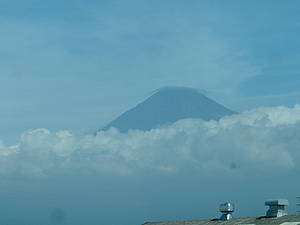
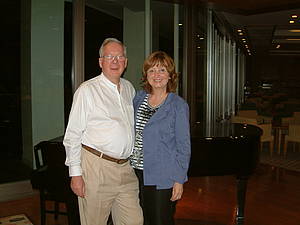
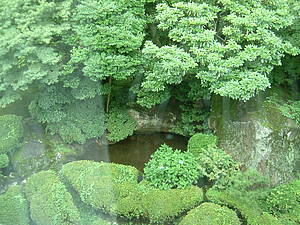
06 -Mount Fuji - Hakone
27th August - Kyoto
We spent the night in onsen hotel in Hakone (onsen is a spa hotel with hot springs) and in the morning went by train to Kyoto. The weather was beautiful, blue sky and sunshine. This enabled us finally to see the promised Fuji from the train and to take good pictures of the holy mountain. We stayed at the hotel New Miyoko near to the railway station and in the afternoon there was an organized trip to the city of Nara, historically the first capital of Japan. We visited the Todaiji Temple with a large statue of Buddha and colorful Kasuga Shinto Shrine with 3,000 lanterns, all donated by wealthy citizens. Both shrines are surrounded by a park, with around 1200 deer and does, freely roaming around. They were tame and expected to get some food from the visitors.
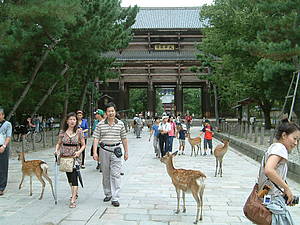
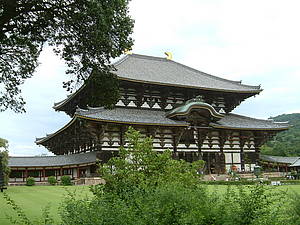
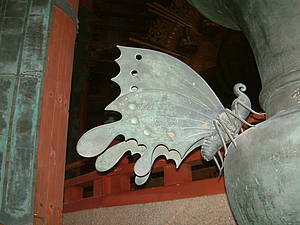
07 - Kyto - Todaji Temple
When it came to the questions about religion, our guides repeatedly explained that many Japanese profess both Buddhism and Shinto. So that we would understand how it works, an illustrative example was given. If something horrible would happen to the Christian, in his anxiety he would pray: “Oh, God, help me, please”. If the Japanese would need some assistance from above, he would most likely pray: “Oh God, Buddha, Ancestors, help me, please.”
28th August
Whole day tour of Kyoto was one of the most challenging ones, as it was stuffy and hot.
In the morning we visited the Nijo Castle. It was founded by shogun Tokugawa (1543-1616) to emphasize the power of shogunate, but on the other hand it showed the uncertainties of that time as there were a lot of security measures included into construction. The famous one is so called “nightingale floor” - when you stepped on the floor, the boards produced a sound similar to nightingale singing, or there was a space for monitoring and watching, sort of attic, on the top of beautifully painted ceilings and carved panels made by painters of Kano School. Nijo castle contains also very dynamic pictures of animals of that time (Japanese painters thought that leopard is a female tiger). In the entrance hall there are figures of feudal lords that give homage to the Shogun sitting on the platform.
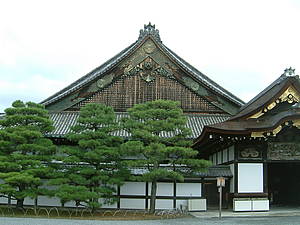
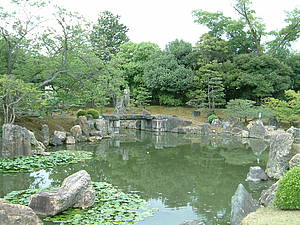
08 - Kyoto - Nijo Castle
Golden Pavilion (Kinkakuji) is situated in the midst of one of the amazing Japanese gardens. Many famous temples were built at the end of 14th century (Kinkakuji was built in 1398). They followed in some ways zen principles of spontaneity, extreme simplicity and moderation, but on the other hand they were similar to Chinese Song-Dynasty temples; the upper floors of the Golden Pavilion are covered with gold leaf, and it is surrounded by traditional water gardens.
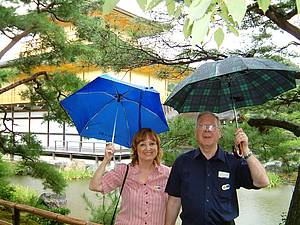
09 - Kyoto - Golden Pavilion
Next stop was the Royal Palace. But it did not impress us at all, it was like a farce. The palace opens only once a day at a certain time, therefore all tourist groups have to come at the same time and respectfully wait four abreast, as in the army (I am not making this up). At the time we reached it was raining again. At the anticipated hour, the door opened and everyone marched in. After all the splendor of temples and shrines seen before it is a real anticlimax. Kyoto is no longer a capital and the Emperor comes to visit his Royal Palace only sporadically. The buildings are mostly of wood and originate from recent time (1855), meaning nothing much from the historical or esthetical point of view. Everybody went through and marched out again. I expected to witness at the gates next group of four abreast tourists, but nobody was there as the quota for the day had probably been already exhausted.
We had lunch in the center of crafts, a six-story building filled from the top to the bottom with Japanese handicraft products of various artistic level – certainly a feast for the eyes and eventually for the wallet. All tours in which we participated were sold including lunch and we got served unusual Japanese food to be eaten by chop sticks.
In the afternoon we first saw Sanjusangendo, a Buddhist temple, with 1,001 bronze statues of Buddha, all of them actually identical, just with a slightly different facial expression. In front of them there are around 40 stone statues of various deities, most of which originally come from the Indian pantheon – very interesting.
After having seen a Buddhist temple and to keep the balance, of course something from Shinto religion had to be visited, this rule was strictly followed all the time. Therefore, we visited Heian Shrine, one of the largest and youngest Shinto sanctuaries, which was built in 1895 with the intention to help to development of Kyoto after Tokyo became a capital. The building itself was nothing special, but the garden and Chinese style bridge looked fantastic.
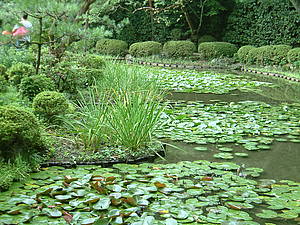
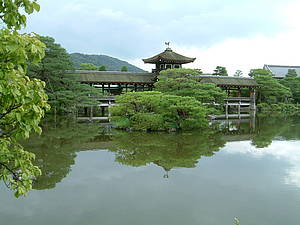
10 - Kyoto - Heian Shrine
In the end we climbed up the hill over Kyoto where Kiyomizudera Temple is situated. It was established in 778, even before Kyoto became a capital and in the 20th century declared UNESCO heritage. Kiyomizu Stage was built using a special method - huge 12-meter high keyaki pillars were assembled without using a single nail and the floor was installed using more than 410 cypress boards. The view of Kyoto from the stage is magnificent. The number of various small shops all around contribute to a special atmosphere.
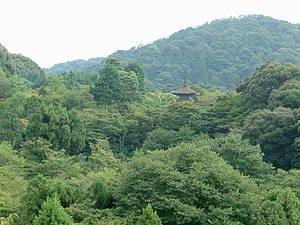
11 - Kyoto - Kiyomizu Temple
29th August
A trip to Hiroshima and the island Myiajima with Itsukusima Shrine.
When we reached the Chugoku region of western Honshu (the largest island of Japan), we were first taken by boat to the Island Myiajima. An impressive torii gate in the sea as an entry to the island and a Shinto temple in the middle of a park area makes it look like a paradise on earth, so that it is difficult to imagine that just a quarter of an hour from here the most destructive weapon in the human history was used 63 years ago and let nearly half of the city population of 350 000 evaporate.
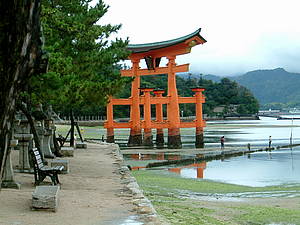
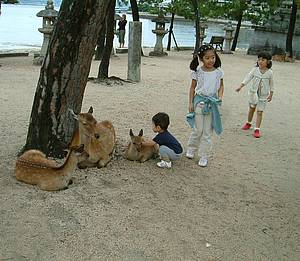
12 - Myiajima Island
Then we were taken to Hiroshima itself. The city has been completely rebuilt. In the museum there is a model of how Hiroshima looked before and after the bomb. No stone was left unturned after the explosion, the temperature in the epicenter reached 4000 degrees Celsius. Among the exhibits there is a molten child scooter and a shadow of a man who simply vaporized on the steps of the bank. As a memento, only one monument had not been restored - a half-ruined dome of the building, which was in the twenties of the 20th century designed by Czech architect Josef Fanta, who designed the same building also in Prague – it is the building with dome housing presently the Ministry of Industry on the waterfront of Vltava river. The guide with tears in her eyes told us that when she arrived in Prague, she admired this dome structure and to realize that the same building could have been standing also in Hiroshima made her cry. The guided tour started in the Peace Memorial Park followed by the Cenotaph for the A-Bomb Victims, the Eternal Light (lit by the Olympic flame in 1962), Children's Peace Monument ( established by the classmates of the girl who died of leukemia 10 years after the bomb erupted), and the Fountain of Prayer. When Japanese talk about Hiroshima and Nagasaki, they do not talk about historical reasons and consequences of what had happened, even children do not have the interpretation in their history books. It is still a painful topic, and a lot of it remains tabu. But all the concept of Hiroshima is based on the only premise: Let us fight together for eternal peace, for destruction of all nuclear weapons, so that something like this could never happen again.
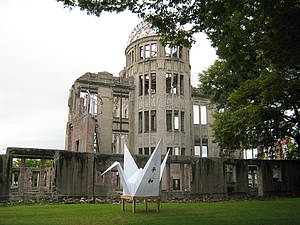
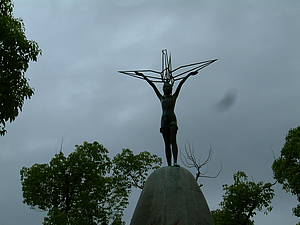
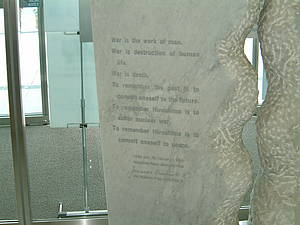
13 - Hiroshima
30th August
Free day in Kyoto. In the morning we admired the modernist architecture of the new railway station and in the afternoon we went to have look at Gion district. It is known as a quarter where the only gambling game Paching is permitted, and a place full of Tea Houses where gentlemen can flirt with Geishas (George was allowed only to dream of that, of course). But it was nice to see number of geishas walking in the streets in kimono. (to see geishas in other places is rare, and traditional kimono is worn by Japanese women only for weddings or other special occasions).
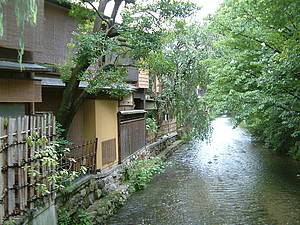
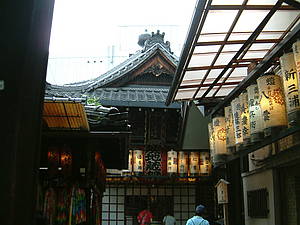
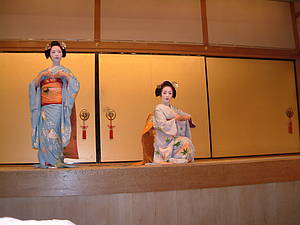
14 - Kyoto - Gion Quarter
We also discovered the oldest Zen temple in Kyoto, founded in 1202 by priest Yousai. He became a priest at fourteen and visited China twice, first time to study the tradition Tendai, second time he wanted to reach India via China but was not successful because of unsteady situation in Central Asia at that time. However, he still met members of Zen sect, who had in China their heyday. Yousai brought to Japan not only Zen Buddhism, but also the tradition of drinking tea, he is considered a founder of the tea ceremony. There were several stone gardens around the temple - in the centre three bigger stones, one of them representing Buddha and the remaining two monks of Zen religion. The area is filled with small pebbles, which are kept in circular, triangular and square lines.
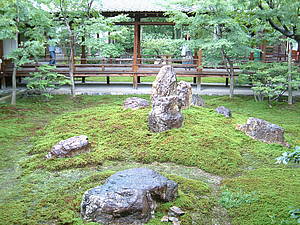
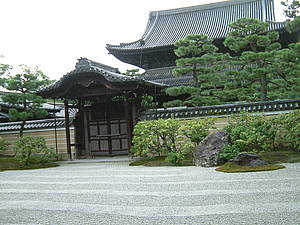
15 - Kyoto - Oldest Zen Temple
In the evening we went to a show to the theater named Gion Corner. The contents of the performance: playing koto - 13 string ancient Japanese instrument, arranging and explaining the art of ikebana, gagagu - the music at the Emperor´s court, kyogen – comical play from the Middle Ages, how the servants tricked their Lord and got access to saké, kyomai – dance of Geishas, bunraku – Japanese puppet theatre.
Then we attended a tea ceremony. Two Japanese ladies showed us first how to do it, and then our group of about ten tourists got instructions to do it ourselves: Pick up the pot by your left hand, hand it over to right hand, pour the hot water into a bowl, rinse the bowl with hot water in a way that you turn it three times clockwise, the selected picture of sakura has to stay in the direction of your body, you support the bowl by your left hand, take it by right hand and pour out the water into a bowl destined for waste water. Take a mini spoon by your right hand, give two mini spoons of green powder into the bowl, pour the water into the washed bowl in the same ritual way as before, but you hold it in a way that sakura stays in the direction outward, take the whisker by your right hand and whip and whip and whip until achieving the foam. It goes on like that, each move is part of the exact ritual, including drinking of the precious liquid and returning all the items to their original position. For once it was good to have this experience, otherwise we would not be able to imagine it properly, but because it was obviously only a simplified form for tourists (tea ceremony would have otherwise lasted several hours), we all felt a bit like in a lesson of chemistry when the chemistry teacher conducted us how to carry out a test (the spiritual dimension was missing), so in the end it was not such an exceptional experience. When we asked geishas, if they perform the “real” non tourist ceremony at home, they laughed and said no. So we believe that this tradition is probably not very much alive any more.
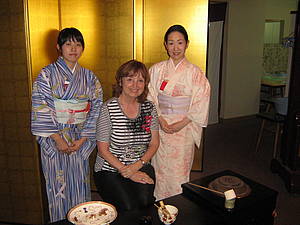
16 - Kyoto - After the Tea Ceremony
31st August
Departure by speed train Shinkansen to Gero, changing the trains in Nagoya was mastered perfectly, which is not to be understood as an easy exercise, because at the time we already had 5 pieces of luggage, two large suitcases, briefcases, computer case plus mini suitcase which we had to buy for an overnight stay in Hakone – other suitcases were sent by travel agency directly to Kyoto. Accommodation in Hotel Suimeikan – Gero is an onsen town, meaning spa with warm and hot springs.
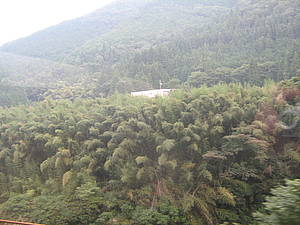
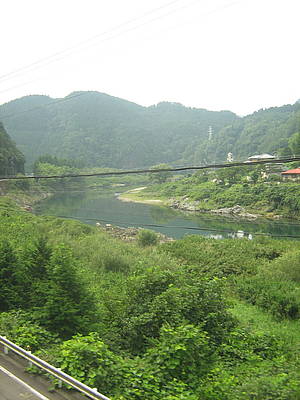
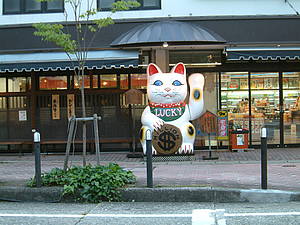
17 - Gero Views
1st September
Trip to Shansso village, which is skansen showing a rural architecture, in the afternoon hot onsen bath.
What is onsen: You come in a yukata (a special bath gown), with only a small washcloth in the bag, everything else except the washcloth is put aside. Special house shoes are taken off and turned by toes outwards. No unisex, men and women attend the spa separately. You sit on a tiny stool in front of a mirror, a hand shower, liquid soap, shampoo and conditioner are available in front of each of the stools. Japanese women will sit on one of the stools and wash herself long and thoroughly. The only normal shower on the wall is always free, that was the one which I preferred to use. Then you enter the pool with warm till hot mineral water. You can remain there around ten minutes, not much more. Then you can cool off with the cold water and repeat the procedure. But in the end you should finish by letting the mineral water on your skin. It feels nice and relaxing, and is supposed to be good for everything: for the nerves, joints, digestion, kidneys etc., etc.
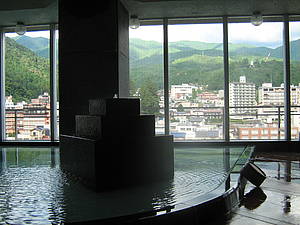
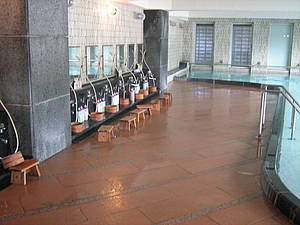
18 - Gero - Onsen Mineral Bath
2nd September
In the morning a two-hours walking tour around, in the afternoon swimming and a stay in hot onsen mineral baths.
We felt in Japan like Gulliver in the Lilliput, everything was too small. Trying to buy a jacket (for me) and a vest (for George) in one of the best department stores in Tokyo was difficult because no one spoke English. Finally we found one such a person and he saved us. They had a special department for Europeans called King Size!!!! So there we finally succeeded, but the selection was of course much smaller than the selection for Japanese.
The same in the bathroom: the sink or washbasin is low as for ten years old child. Hotels deliver to their guests not only soap and other cosmetics, but also hair brushes and toothbrushes. However, toothbrushes are of the size as if for our three years old child who just started to clean his/her first teeth. The same situation in the pool. Because they do not want that anybody gets drowned, the level of the water must enable you to reach everywhere. However, in Japan reaching means a maximum depth of 1.25 m. When I climbed out of the swimming pool on the ladder, I was surprised that it did not go that easy – then I found the reason – I could not put my feet on the rungs of the ladder properly, because they were adjusted to the size of Japanese feet and therefore the ladder was too close to the tiles.
Some characteristics of Japanese people – as seen during our short stay:
- extremely polite, they bow perhaps a hundred times a day
- very much willing to help
- knowledge of foreign languages very week, although they try – we were told that they start learning English at the age of 14, which is apparently too late – it surprised us because we considered Japan to be a country with developed exports
- it was also surprising how unimaginably loud the Japanese can be when gathered in groups (probably worse than Chinese) - for example when there is a group of Japanese people sitting at one table in a restaurant, nobody can hear his own word. The same when a group of Japanese males enter the hotel reception
- teenagers - all wear what's hot in the town - the brown-colored long straight hair, tiny shorts supplemented either by boots, or by knee socks up over the knees - looking really like manga girls
- fantastic order reigns everywhere, littering or doodling on the walls does not exist, we did not see one single graffiti, they are proud of beautifully landscaped gardens around their houses
- collective spirit and keeping the rules - everybody walked around the onsen hotel all day in yukata (bathrobe), but men had to have a different pattern from women. On one occasion, George put on by mistake my yukata and went to the swimming pool (the sizes are the same), but Japanese could not have it and immediately gave him another “male” yukata to change. When you put on yukata , the left side of it has to be below the upper part (meaning right side is on the top). Conversely, it is done only for the deceased (in the hotel we could see one hundred percent compliance with this rule – fortunately we have not seen any deceased, so we could not check on them). This meant that even for opulent lavish ten-courses dinners in a good spa restaurant all Japanese men were coming dressed in a yukata with “male” pattern and all Japanese women in a the same yukata with “female” pattern. I cannot imagine that you would be allowed to come for dinner to a spa restaurant in a bathrobe in Europe – but this custom is strongly supported in Japanese onsen hotels.
- The shoes in a closet or standing against the wall have to be stored with toes upfront, otherwise it would bring bad luck (all are respecting this rule). The slippers, which the hotel makes available are of two types, one for the room, the other one for the toilet. When you go to the toilet, it is assumed that you take off the slippers designed for the room and put on those that are worn for the toilet only. If a person wants to enter the mat in the middle of the room, where there is a low coffee table with cushions for sitting (in some places there are seats with backrests) during the day and futons for sleeping at night, even house shoes have to be taken off. We as Europeans have solved this problem by simply taking off the shoes in the entry hall and walking barefoot in the room in the same way we do at home
- karaoke - at the Gero hotel there was one large and several smaller rooms used for karaoke. They were usually rented by a company to strengthen the collective spirit of their employees which resulted probably as usual in the situation that the subordinates had to listen to their seniors´ quacks and even to applaud them. George tried to persuade me that we had no access to these karaoke rooms. I was convinced that I could get myself in and that the Japanese would love it but when we were sitting at the reception and I could hear (even through the closed doors) what sounds were coming out of there, I decided that I better did not want to be admitted to the party.
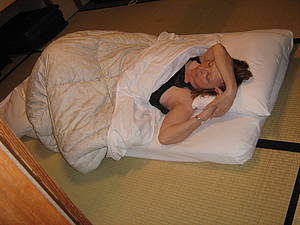
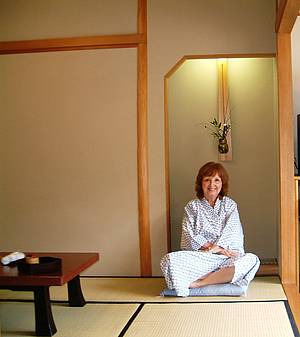
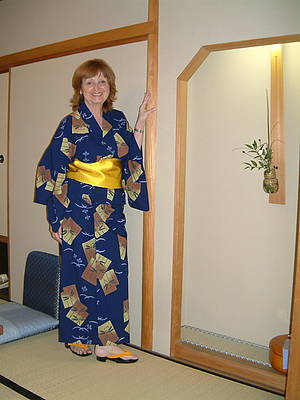
19 - Gero - in the Japanese hotel room
3rd September
One hour hike up to the mountain, swimming and hot baths.
More interesting information about the Japanese:
Health and Safety first! What a difference to India! E.g. when repairing the slightest piece of road, street drains or the like, there is a cop standing there, everything is marked and barricaded to prevent anybody from falling into the ditch. And all the workers, even those repairing the streets, wear helmets, as if they would expect that a meteor could fall on them.
In the elevator on the door, there is a tag with a picture showing a crab with claws nipping a little finger. This is a warning for children not to shove a finger into the elevator doors when it gets closed.
Smoking in Japan is not finished with, vice versa there are spaces reserved for smokers everywhere, to our big surprise even in the spas. And in our hotel room we found a beautiful tag on the bed, in English and Japanese: “Please do not smoke in bed.”
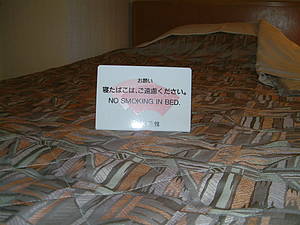
19a - Gero hotel - No Smoking in Bed
4th September
We planned a trip by train to Takayama, a town an hour away from Gero, also an onsen town. When we woke up in the morning the sun was shining beautifully. Takayma could be called a little Kyoto, it is full of historic buildings, small shops and restaurants, and other attractions. We strolled along narrow lanes down by the riverside, enjoyed the atmosphere and visited one of many traditional plants for production of saké (rice wine) including tasting. We also visited Takayama Jinya, an administrative building from the time of the last shogunate, the only one of original sixty preserved to this day. Takayama Jinya was originally established as a government outpost in order to bring the Hida Province under the direct control of the shogunate (1692). Twenty-five government officials coming from Ed were commissioned to Takayama for administration, finance management, police supervision and litigation - it all took place in this building for 176 years. Tokugawa Yoshinobu was the 15th and last ruling shogun. He was part of a movement which aimed to reform the aging shogunate, but was ultimately unsuccessful. After resigning in late 1867, he went into retirement, and largely avoided the public eye for the rest of his life. So we visited the area where people could submit their petitions, places for celebration and others for trial and torture.
Takayama´s highlight is an exposition of the so-called Yatai or in English, Floats. They look like allegorical floats we know from the contemporary parades, but they are not on the wheels - like a giant stretcher they have to be borne on the shoulders of at least 80 people of the same size. Many of them come from the 17th century, and are decorated with elaborate gilded carvings and metal decorations. In Takyama there are two festivals held in April and October (Takayama Matsuri) which belong to three most beautiful festivals in Japan. The floats procession moves at night through the city lit with torches and it must apparently be a fantastic spectacle. The museum also exhibits a complex of Nikko in miniature, the visit of which is accompanied by light effects of sun dawn and sun set over the temple and by emotional music. Another curiosity of the museum is a collection of lion masks and Karakuri puppet theater, whose performance we could also admire. The self-motion mechanism of these puppets was invented in the 17th century by a clockmaker, who used to have the task of repairing watches belonging to shogun Tokugawa. When he studied the interaction of spindles, little wheels and springs in the watches he got an idea that the same system could be used for animation of the puppets. These puppets were then used not only for performances but also at the festivals.
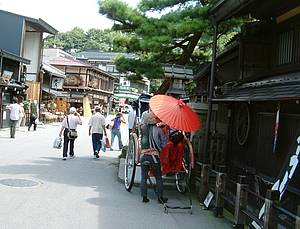
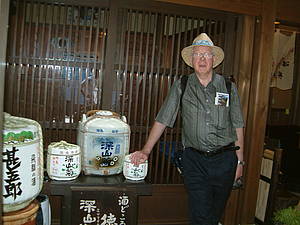
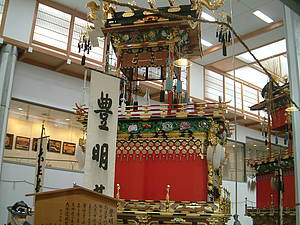
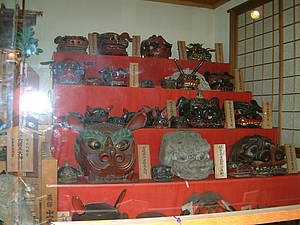
20 - Takayama
On the way back to Gero we experienced how changeable the Japanese weather can be. Suddenly it was completely dark, the clouds rolled into the mountain valleys and it began to pour cats and dogs. The evening was then dedicated only to a hot tub and swimming. For dinner we got served instead of regular 10-course Japanese dinner “only” 7-course French menu. But they did not have French wine, so we ordered saké instead as usual. We could easily get used to it. I asked the room service to prepare for me a futon bed for the night. I slept very comfortably.
Everyday examples of advanced technology of Japan:
- “Green car” wagons on the train enable to rotate the seats located behind each other in a way that the passengers can sit facing each other if they wish so. It is done just by pressing one button, ideal especially for families with children.
- Turbo hands dryer at many restrooms - hands are dried in seconds (in the meantime this system started to spread in Europe as well, but much later)
- Characteristic indispensable equipment of the guides (also known in our countries but not so widely spread) was a microphone stuck to the collar for outside excursions and the beeper for counting tourists (done every time after returning to the bus).
- The biggest dream invention is a Japanese automatic toilet. Wherever we lived and in most public conveniences, there is a heated toilet seat, washing the back side is effectuated by pressing a button, where you can program the water temperature and the pressure of the water stream (nothing so primitive as our little shower next to the toilet, or on the other hand nothing so complex as an extra bidet). All this is followed in many cases by automatic flushing about three seconds after the person gets up. Not to mention the various scented essences sprayed all around. It is really the first class and you could very quickly get used to it.
5th September
We went for a trip to the capital city of Gifu prefecture, which also includes "our" Gero.
We used again the Rail Pass, which is a pass for prepaid train service on all state trains that we obtained in India (it is not possible to get it in Japan). It worked perfectly. With the Rail Pass you need to pay nothing more, you can only pick up your seat reservation when you do not want to take a risk of standing in carriages for which reservations are not issued. After arrival to Gifu, we took the cable car up to the middle of the highest Gifu mountain and then climbed up to the top to see the Gifu castle. It was hot and humid but we were rewarded by beautiful photogenic views. The present castle is a new replica of the old one originally built in the 17th century. Most interesting was the exhibition of Samurai armor and various other artifacts from the Samurai period.
While getting down the hill rather late we nearly missed the lunch. We did not know that all restaurants would close at 14 – 14.30 to be reopened again for dinner only at 17.00. We barely managed to reach a nice crab restaurant at 14.30, but they were just about to send us away – finally, after I used all my available weapons, we were let in and served crab salad and crab claws which we thoroughly enjoyed.
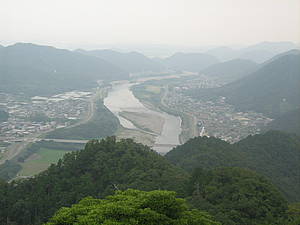
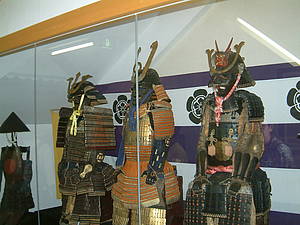
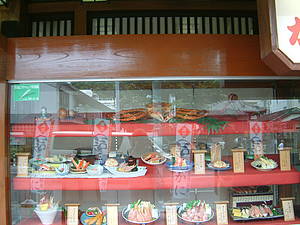
21 - Excursion to Gifu
Last dinner in our hotel Suineikan was, as we were told in advance, Chinese, with "only" eight courses. We were seated into a different room, directly against the window so we could admire the view at the lake with bamboo, just in style.
That evening I also wanted to try a Japanese massage which is similar to Thai massage. Because of the language misunderstandings (there was only one person in the whole hotel who spoke English and had to be called every time when we had some questions or wishes), the masseuse came into our room whilst I thought that the massage would take place in the beauty salon. (I made an appointment at the reception). She did not want to leave, although George tried to explain to her that I left for the same massage to their premises on the 2nd floor. She did not speak English and continued offering him the massage he did not want. In between I was waiting upstairs at the lounge of the beauty salon where the receptionist, totally in panic, looked for somebody who could say at least couple of words in English, because she was not aware what I wanted. After 10 minutes two ladies from reception reached, they apologized for misunderstanding and offered me a European massage including all scents and oils for 14000 yens, they could cancel the ordered masseuse, no problem (till then I did not have a clue about her existence as she was still sitting in our room trying to convince George that he should have Japanese massage for 4500 yens). So I assured them that I wanted only and specifically a Japanese massage and that nobody should be cancelled. I went back to the room where George meanwhile successfully got rid of the masseuse and locked himself in the room not to be bothered any more. When they finally got hold of the masseuse again, he better went out for a swim and a warm bath to the spa. But in the end, after all these hardships, the massage was perfect. The little Japanese girl asked me to lie down on the bed (of course, in yukata, because you are not naked for this type of massage), knelt on the bed beside me, used a silk cloth so that her hands would be better sliding, she circled all around me and really took care of every single bone and muscle of mine.
Additional notes on life in Japan
- The Japanese do not like colors in their architecture. All constructions, residential buildings, whether family houses, tenement houses or skyscrapers, have facades of beige, brown, or gray color. The maximum daring is that recently some owners of family houses used dark blue tiles for their roofs. Pink, pale blue, yellow are nonexistent in the housing projects. I would not miss these colors too much, but what about white, or red, or green? Well, simply said, the Japanese definitely dislike pastel, gaudy and saturated hues.
- Our smart book about Japan informed us that European and Indian cell phones would not work, so we let one mobile phone with Japanese SIM card to be forwarded to the first hotel and were delighted about the offered service. The reality was different. The Indian cell phone worked flawlessly, as well as the internet in all hotels. But we never managed to get the a Japanese cell phone functioning, so we did not use it at all and sent it back to the renting company who deducted the due amount from our credit card, but as a part of their perfect services supplied also self-addressed envelope and stamps for the return of their mobile. So we followed the instructions, and sent it back.
- In Japan, no one takes a tip. We read about it first in the travel guide and waved it off, thinking, that eventually everybody likes to get something, and why not, if the service is good. But the book was right in this point. The Japanese really take no tips. When we offered something to the porter for bringing us the suitcase to the hotel room (he was alone with us), he said that it was a company policy not to take tips and that it was a pleasure for him to assist us. The restaurants brought back the change to the last yen and when we tried on two occasions to give them something because we were really satisfied, it was also refused. The taxi driver did not take any tip either. At the end of our stay at the spa in Gero, we wanted to reward the hotel staff for a really nice stay, which they tried to make pleasant for us and they really went out of their way to make us happy. They borrowed me kimono so that I could get a feel of Japanese traditional dress, the chief waiter tried to explain us details of every dish from 10 courses dinner menu, although he could not speak English, the lady interpreting for us was always at our disposal. However when it came to the tip, they bowed to the waist and did not take anything. I do not think that there is such another country in the world.
6th September
In Japan, there are no baggage carts at the railway station! Or they were hidden somewhere. Because of this situation, our journey with changing the trains two times (Gero - Nagaya - Tokyo - Tokyo Narita - the airport station in the vicinity of which we had booked a room in hotel Radisson) became a nightmare. We always have a problem that we are unable to travel light, but this time it was extreme. Just to illustrate the situation, these were our pieces of luggage:
· Suitcase Ivana - 25 kg
· Suitcase George - 25 kg
· Computer case George
· Computer rucksack Ivana
· Extra small suitcase on the wheels bought for overnight stay in Kyoto filled with purchased articles
· Handbag Ivana
· Wooden decorative souvenir, looking like carved long rod with hook on which Japanese used to hang the tea pot over the fire in the old days
· New boater George - in the end we forgot it in the last hotel Radisson, but they sent this hat (bought in Japan, therefore sort of souvenir which George liked) nicely packed in a box to our Indian address – an unbelievable service
Finally we had successfully managed to drag all this luggage to Hotel Radisson. It was quite an achievement not only because of the number of luggage but also because of the complicated search for platforms when changing the trains (not all signs were in English, but the Japanese were always willing to help), not speaking about hot and stuffy weather.
7th September
The shuttle to the airport was schedule for 8:30 am. Even before we reached the airport, the police stopped the minibus and wanted to see our passports. When we saw this procedure, we started to fear the worst, given the number of our luggage and especially one extraordinary piece (hanging rod). But surprisingly, at the check-in everything went perfectly well. The overweight (our two large suitcases weighing more than 50 kg) was never mentioned and the "dangerous" souvenir (hanging rod) passed without any problems. And everywhere, as always, there was a lot of typical Japanese politeness and willingness to help.
Good bye, Japan ...
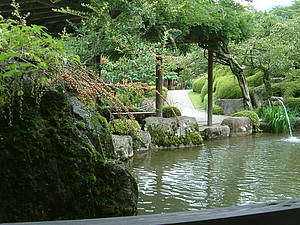
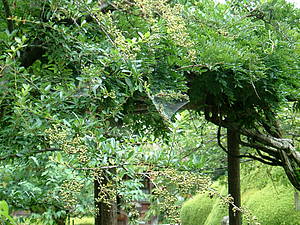
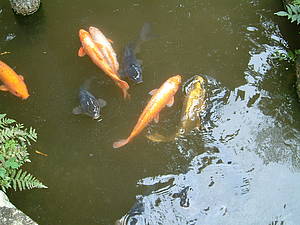
22 - Natural Beauties of Japan


